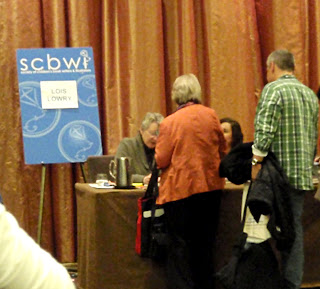It was two weeks ago this weekend that I attended this year's SCBWI Winter conference in New York City. While it is still somewhat fresh in my mind, I'm going to share some of what I learned from the various panels and speakers that presented throughout the weekend.
Saturday morning, January 29th, Lois Lowry opened the conference with a beautiful keynote talk where she answered some of the questions sent to her by her young readers. Throughout the talk she shared insights on where she gets her ideas and told fascinating stories of her childhood growing up in Japan and funny stories about her return to America and, as a young girl, her awkward introduction to summer camp. She told about how her father's memory loss helped give her the idea for her Newbery award winning book, "The Giver," and how stories from a friend's childhood inspired her other Newbery winner, "Number the Stars." It was heartbreaking to hear her tell how the early death of an older sister, inspired her book "A Summer to Die." Her entire talk, filled with vignettes from her life, showed how incidents in one's life can lead to inspiration for storywriting. She said how important it is to give words to sorrow, to give words to fear and to give words to anxiety. Throughout her talk, she put slides up on screen, some of which displayed rhymed couplets that explained her writing process. Here are a few of them:
 |
| Lois Lowry |
"Things that happened way back when
told and shaped and told again."
"From the past a whispered hiss
of guilt and shame - remember this?"
"Remembered grin, familiar frown
grasp it - name it - write it down"
She talked about how her stories often had roots in the question "what if?" What if a society could choose to forget about pain and loss? That "what if" question is the one that led her to write "The Giver."
She also told a story about how her father was the dentist to Richard Nixon's daughters, Julie and Tricia and how he would constantly talk about how well behaved and polite they were. These anecdotes led Ms Lowry into an explanation of how the inspiration for her character Anastasia Krupnik, came from the daughter of another president, Jimmy Carter's daughter, Amy. Lowry said that she felt Amy Carter was a much easier child to relate to than Nixon's girls. Amy Carter had public tantrums, her mother dressed her in ugly clothes, she wore big eye glasses, etc. In other words she seemed much more like a real girl.
Lois Lowry's speech was followed by the day's first panel, a panel devoted to picture books entitled, "Creating and Recreating the Picture Book: Three Views." The panel was moderated by Lin Oliver (a woman who could have been a successful stand-up comedian) and featured three guests: Jane Yolen, Mark Teague and Patricia Lee Gauch.
 |
| Jane Yolen |
Jane Yolen (known as "the Hans Christian Andersen of America") started off the panel talking about how much work and dedication is involved in writing a picture book. She also shared some things an author needs to know when writing one:
1) lyricism - the text needs to have a lyric sensibility, a resonance. Some examples she gave of text with lyricism were the lines, "Let the wild rumpus begin," from Maurice Sendak's "Where the Wild Things Are," and "Under the Shining Owl Moon," from her own book, "Owl Moon."
2) Compression - time, emotions, and characters are compressed in a picture book, so the words have to do double and triple the work.
3) Child centeredness - this does not mean that your story has to have a child as the main character but it does mean that the emotional key has to resonate with a child. Some examples she gave are "Officer Buckle and Gloria," by Peggy Rathman where the main character is a policeman and his police dog and "A Sick Day for Amos McGee," this year's Caldecott winner by Philip Christian Stead, a book whose main character is an elderly man.
4) A hook - your story will need something that will get the child into the book.
5) Words - pick your words as carefully as a poet would. Use big words as well as small words and sometimes make up your own words.
5) Illustratibility - think in terms of pictures, think physically, make sure there are things in your writing that an illustrator can illustrate.
6) Emotional resolution - for a picture book, it's important that you resolve the emotional issues of the story. Think about the ending of "Where the Wild Things Are."
 |
| Mark Teague |
Mark Teague, the illustrator of several of Jane Yolen's books including the popular "How Do Dinosaurs Say I Love You?" followed with his insights from the illustrator's point of view. His talk felt very spontaneous (which may have been due to the fact that he was called in at the last minute to replace David Small who was originally supposed to be the representative illustrator) and flowed easily from one topic to another. He spoke about how important it is for the illustrator to match the images to the lyricism of the words and to hopefully extend the text by showing things that aren't explicitly spelled out in the author's text. He said a picture book illustrator needs to be a good reader - to understand the mood, the bounce and rhythm of the text. He also encouraged illustrators to experiment, to learn new techniques through trial and error, to try anything as long as you remember that you are working in service to the story. Try and find the things that are individual to you and avoid visual cliches. If you are going to draw a dog, don't make it look like every other dog illustration you've seen, but make it your own dog, in other words, put something of your own personality into your dog illustration. He ended by reminding illustrators to concentrate on the wonder and mystery of the story, to those things that are happening beyond the edges of the page.
Patricia Lee Gauch, an editorial director of Philomel Books reminded us that storytellers have never had it easy and that some of what we know about fear, loss and emotion is stored in our gut. She told us to go to the well, the rag and bone shop of our hearts. She told writers, "let the stuff from the deepest part of you choose your story." She also said to try and "see your narrative as a wave that you feel, feel the swell of it. . . . go for the catch in the breath." In talking about picture books she reminded writers that interesting things need to happen at each page turn and not to forget the middle of the story. "Middles are important!" she said.
 |
| Sara Zarr |
Sunday, January 30th was the final day of the conference and it ended with two keynote speakers. The first was by Sara Zarr, author of the young adult novels "Story of a Girl," "Once Was Lost," and "Sweethearts." She talked about living and sustaining a creative life. She started off by telling the audience that it's impossible for an author (or illustrator) to know how long it's going to take before that one big break comes along. Because of this uncertainty, it's important to craft and nurture a creative life. She emphasized the importance of loving the work that you do and remembering that publication is not the end result. You have to remember that what makes you happy will keep shifting. Right now, publishing your first book might be the thing that you think will make you happy, but once you've achieved that goal, it will be something else that will make you happy. Since those things that make you happy will change throughout your life, it's important to love the work, crafting a sustainable creative life that will keep you centered. You must find things that engage you, that tap into something deep inside of you, things that excite and expand you. She said to ask yourself the question, "Do you wake up in the morning eager to create?" The answer to that question will tell you a lot about whether you can sustain a creative life. She suggested to seek out mentors or become a mentor yourself. If this isn't possible, than she suggested that you read biographies of artists that mean something to you. She also said it was important to be choosey about who you share the chief issues of your creative life, know when to keep things private, think before sharing and know when it's time to send company away.
The importance of having faith in your creative life can't be underestimated. To illustrate this point, Zarr shared a quote by Flannery O'Connor, "People without hope don't write novels." She went on to say that you need to have faith that what matters to you will also matter to other people.
On the flip side of the coin, Zarr also talked about those things that can make a creative life unsustainable. She included unsustainable habits, things that will eventually take a toll on your life, things like not getting enough sleep, not enough exercise, existing solely on junk food, etc. She also pointed out that there is no artistic romance in being self-destructive.
One of the points that stuck with me in Zarr's talk was when she said we can choose how we experience our lives. For an example she said, "if you're stuck in traffic and getting stressed out and start to yell and pound on the dashboard (something I often find myself doing), is that really going to make the experience any more pleasant?" She went on to say how important it is to figure out what you need in order to be in a good place to do your work, to learn what facilitates your creative life. What are the things you need in your life to do your best work?
Some other tips from Zarr's talk:
Save the drama for your work.
Nothing will happen unless you do your work.
Don't obsess over the process, i.e. reading about how to write, how to illustrate.
Finish things, don't plan so much, just do it.
If you see the value of your creative life only in terms of what the marketplace values, you'll stop doing creative work.
Don't become disenchanted. Disenchantment is the opposite of engagement.
 |
| Linda Sue Park |
The final keynote of the conference was given by Linda Sue Park (the Newbery award winning author of 'A Single Shard). Her talk emphasized the importance of believing in the work. She talked about the importance of a good story and how, by reading a lot, one can learn what's a good story by creating a mental standard, a scale in your head of what you like, a mental storehouse of books you've read that you can use for comparison for what's good and what's not. She stressed the need to focus on your story rather than on your own insecurities of whether you think you can do it or not. Stop telling yourself, "I can't do this, I don't know anything about this, etc. Stop making it about yourself and make it about focusing on the story. Two things that she impressed on the audience were, "When the story matters more than your feelings, the work will start to flow," and "Courage is when you are afraid of the project and you do it anyway."
There are so many other things I could write about my three days at the SCBWI conference. I haven't even mentioned the legendary Jules Feiffer and his suggestion to approach your work as if it were play, not to mention his advice on how important it is to entertain the possibility of failure, "If it doesn't work, so what? Make it work." Another speaker who I left out was Goosebumps author, R.L. Stine, who gave a hilarious keynote speech during our Saturday luncheon. I also didn't mention the informative after hours group discussion I attended on LGBT publishing that was hosted by Lee Wind. As you may have gathered, this conference was filled with advice, information, and inspiration. It was like a three day banquet where each day you were presented with a sumptuous meal, each course filling you up, but still leaving you with the desire for more.
 |
| Jules Feiffer |
 |
Lois Lowry signing autographs
|













